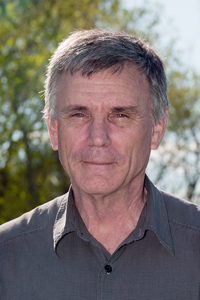Phil Hogan

Phil Hogan is the District Conservationist for the USDA Natural Resources Conservation Service in Woodland. He and the Service help landowners with conservation issues by restoring wildlife habitat, installing water conservation measures, and doing other similar projects.
Could you describe where you are and what you see around you?
Well, where we’re at right now is within a riparian forest of Cache Creek Nature Preserve. The Cache Creek Nature Preserve serves the very important purpose of educating school kids and adults about the value of native riparian areas. In California, only about 5% of the native riparian habitat still exists after European colonization cleared for agriculture and building the towns of Woodland and Davis.
Could you tell us more about the riparian habitat in the preserve?
I understand there was a big drought. In 1978 and ’79, I believe it was. It lasted for two to three years and was so severe that the groundwater tables went down quite a bit. [This] caused the native riparian habitat to die because the roots of the native riparian plants, such as willows and cottonwoods, could no longer tap into the groundwater. Introduced phreatophytes,such as arundo and tamarisk, which have much deeper roots, were able to tap down into that groundwater.
Why is this place important?
Well I think the creek and the preserve as a whole are very important because, as I mentioned earlier, there’s only about 5% of the native riparian habitat left in California. Cache Creek is what I’ve always kind of called the “lifeline” or the “lifeblood” of Yolo County. And Cache Creek is one of the very few native streams and creeks in Yolo County that has not been straightened—it still kind of meanders along its natural course. It’s a source of gravel as well.
Can you tell me about an activity that you have been involved in on this land?
The USDA Natural Resource Conservation Service has gotten involved with Cache Creek mainly in the past by stabilizing the stream banks. Most of the work we’ve done is up in Capay Valley itself. A lot of homes and barns and other structures [there] are in danger of falling into the creek if we weren’t going in with the Emergency Watershed Protection Program. That program stabilizes the banks by placing rock riprap so that the bank no longer erodes.
Unfortunately, there are areas where homes, buildings and structures were allowed to be built in the flood plain. When those do get in trouble, we should go in and build the riprap and protect those structures and preserve life and property. There are other areas where it’s more appropriate to just let the river meander in its own course.
What do you think about the preserve and what are some of your favorite experiences here?
I think the preserve is a wonderful place; it provides a lot of educational opportunities. My son is involved in one of the local Boy Scout troops here in Woodland, and a lot of Boy Scout Eagle projects have been taking place out here at the Cache Creek Nature Preserve and providing a lot of educational opportunities themselves.
What is unique about this property in terms of wildlife?
The Cache Creek Nature Preserve is a nice island in this sea of urban and rural agricultural areas that provides opportunities for wildlife to congregate. You have waterfowl, you have mammals, you have reptiles. We have to look at nature and the ecology as being intertwined and interdependent. If our whole society was nothing but urban areas and agricultural areas, then there wouldn’t be a respite or a place for people to come and recreate and relax during their off times.
Did you have a role in the gravel wars at all?
I did not have a direct role in the gravel wars myself; it was a big topic with the Yolo County Resource Conservation District. Back in the early 80s when I first arrived, their main priority was protecting the creek from aggregate mining, or at least improper aggregate mining, which I don’t believe happened. We wanted to make sure the areas that had gone into aggregate mining were restored back to their native riparian habitat as much as possible. So I remember those night meetings—we’d go to midnight sometimes—about what was the best way to restore a native riparian habitat in areas where gravel mining had taken place.
Is there anything else you want to say to wrap it up?
I think the only other thing I’d like to say to wrap it up is that Yolo County, whether everybody realizes it or not, needs the Cache Creek Nature Preserve. As I said, it’s an island; it’s an oasis of native riparian habitat in the midst of urban [areas] and farming. I think providing those corridors and those lengths between individual sets of riparian parks and preserves would help to restore the natural function of Cache Creek, which is to provide for wildlife habitat, to provide groundwater recharge, and to provide for cleaner water.
To download the audio, right click on the audio link above and scroll
to "Save link as . . ." and choose the directory where you want to
store the mp3. In Windows, you may have to use Control + S to select the link.